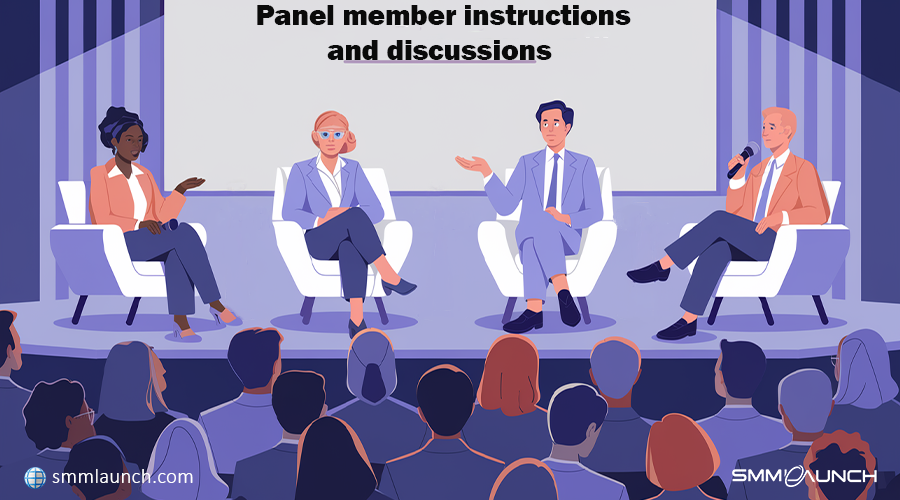
Essential Panel Member Instructions for Effective Discussions
Panel discussions are a staple at conferences and professional gatherings where experts in a field share their varied perspectives on important topics. Whether or not the panel discussion is a success depends on how well the panelists are guided through panel member instructions to ensure a cohesive and engaging dialogue.
Ever wonder what makes a panel discussion go from the typical to the great exchange of ideas? The secret usually lies in how clear and effective the panel member instructions are to its members.
Panel discussions are interactive platforms where experts debate on selected topics, offering audiences strategic insights. If well done, they can be effective in giving knowledge and at the same time become stimuli to more critical thinking or calls for action by the audience. In any case, their quality depends directly on how panelists are prepared to perform through proper panel member instructions.
Table of Contents
- Importance of Clear Instructions in Panel member instructions
- Key Instructions for Panel MembersA. Define Purpose and Objectives
B. Know Your Audience
C. Assign Roles and Topics
D. Encourage Preparation
E. Foster Collaboration
F. Handle Q&A Effectively
G. Focus on Engagement
H. Address Logistics and Etiquette
- Challenges and Solutions in the Panel member instructions1. Lack of Preparation
3. Off-Topic Conversations
4. Poor Engagement with the Audience
5. Poor Time Management
6. Overly Self-Promotional
7. Technical Issues
- Conclusion
Importance of Clear Instructions in Panel member instructions
The key to any effective panel discussion is giving the panelists clear directions. Here's why:
1. Facilitates flow in discussions
Clear guidelines on the role of panelists, order of topics, and time allocations, provided through detailed Panel member instructions, help the panelists understand their roles. This ensures an orderly, dynamic conversation that is not dominated by one speaker; instead, the balance of participation will be ensured.
2. Increases Audience Involvement
Well-prepared panelists can identify the salient points to be discussed and relay factual information to them. A structured approach will accommodate interactive elements such as Q&A sessions, creating conditions for an inclusive and participatory environment.
3. Ensures Overall Success
Effective instructions ensure coherence of discussion based on set goals of discussions. It therefore, allows panelists to effectively make contributions, which aim towards meeting the goals set by the events.
This effectiveness creates a whole lot of memories and impressions on each and every individual within such an exercise. In a nutshell, clear panel member instructions are what will allow for a well-coordinated panel discussion that is interesting to the audience and successful in achieving its intended results.

Key Instructions for Panel Members
Divide this section into clear subsections:
A. Define Purpose and Objectives
• Clearly defined objectives: Know the whole reason for the panel. Is it to educate, inspire, or even debate? The clarity makes the discussion stay on target.
• Align Contributions: Assist the panellists to appreciate how to relate their contribution and comments, with the purpose of the panel. Panel Member Instructions: For instance, if the intention is to motivate, then personal unique stories of experiences endured would be apt.
B. Know Your Audience
•Tailored Content: Understanding the audience is key to resonating with them. For example, a corporate audience may prefer data-driven insights, while a creative audience might appreciate innovative ideas.
• Practical Tips: Provide demographic information, age, professional background, and interests in order for the panelists to be able to tailor examples and analogies that resonate best with them.
C. Assign Roles and Topics
• Clarity in the Role: Distinct role definitions must be present, for example, expert on the matter, devil's advocate, storyteller, etc., adding depth to the discussion.
• Structured Agenda: Pre-allocated topics with time allocations allow for a more coherent and balanced flow. Structured discussions help avoid the recurrence of the same topic by different speakers.
D. Encourage Preparation
• Research and Points: Instruct the panelists to research facts, prepare examples, and summarize their insights into key messages.
• Practice Sessions: Suggest a pre-panel meeting or rehearsals where views of the panelists can be bounced off against each other for feedback so that everyone gets on the same frequency.
E. Foster Collaboration
• Teamwork: It's a matter of mutual respect and listening to each other as the foundation of fruitful discussions. Panel member instructions emphasize the importance of pre-event rapport among panelists, which can really help in enhancing synergy.
•Interactive Tips: Encourage panelists to build upon each other’s points to create a dynamic and engaging discussion.
F. Handle Q&A Effectively
• Anticipation: Training the panelists to anticipate the questions likely to come from the audience and prepare clear and concise answers.
• Focus on Relevance: Encourage avoiding long-winded responses and redirecting unrelated questions politely back to the topic.
G. Focus on Engagement
• Dynamic Styles: The usage of storytelling, humor, or rhetorical questions can amaze audiences. Slides or other support materials will make the presentation more intriguing.
• Interactive Strategies: Suggest incorporating live polling to retain the interest of the audience or encouraging audience participation in discussions.
H. Address Logistics and Etiquette
• Practical Matters: Informed panelists about things like the use of microphones or slide presentations. Also, be sure they have a sense of the overall schedule for the event.
•Professionalism: Stress for punctuality, apt dress, and tone during the entire engagement.
Challenges and Solutions in the Panel member instructions
Buying Telegram members involves increasing a group or channel’s member count by purchasing real or bot accounts. While it may seem like a quick way to boost numbers, it carries risks such as low engagement, platform penalties, and credibility damage if discovered. Similarly, panel discussions, often valued for sharing diverse perspectives, face challenges that can hinder their effectiveness. To address these challenges, Panel member instructions play a crucial role in ensuring effective moderation and participation. Just as real members may leave if content lacks value, poorly managed panels lose impact. Success in both requires authenticity, meaningful interaction, and quality content.
1. Lack of Preparation
• Problem: Poorly prepared panelists give shallow insights, leading to a very disengaged audience.
• Solution: Provide discussion themes and objectives far in advance to encourage panelists to prepare extensively.
2. Dominating Discussions
• Challenge: The domination of one panelist can limit the variety of perspectives and decrease audience engagement.
• Solution: Establish guidelines that call for balanced participation. The moderators will have an active role of managing the time taken by each speaker, so that the discussion may be directed back to all panelists.
3. Off-Topic Conversations
• Challenge: Deviating from the main subject may confuse the audience and dilute the impact of the discussion.
• Solution: Agenda setting with predefined topics. The moderators should bring the discussion back to the agenda in case of deviation, so that the discussion aligns with the objectives of the panel.
4. Poor Engagement with the Audience
• Challenge: The limited interaction with the audience will reduce interest and participation.
• Solution: Incorporate Q&A sessions, live polling, or collecting questions from the audience in advance into the format. Encourage the panelists to speak directly to the audience and to address the audience's interests.
5. Poor Time Management
• Challenge: Overextended discussions may lead to rushed conclusions or missed topics.
• Solution: Allow specific time allotments for each segment of the discussion. The moderators should keep the time and ensure that panelists are made aware in order to hold a well-balanced pace.
6. Overly Self-Promotional
• Challenge: When panelists focus on self-promotion or the promotion of their organizations, it detracts from the value of the discussion.
• Solution: Establish expectations that the focus should be on providing valuable insights, not self-promotion. Moderators can step in if a panelist starts to get too promotional.
7. Technical Issues
• Challenge: Technical problems can make the discussion incoherent and less professional.
• Solution: Conduct technical rehearsals before the event to make sure that all the equipment is operational. Have backup plans so that if some technical problem occurs, it could be resolved as soon as possible.
Conclusion
The success of a panel discussion is thus very much based on how clearly and effectively instructions have been given to its members.
Furthermore, SMMLaunch is the best SMM panel for Telegram marketing services. They provide budget solutions to increase your Telegram channel or group with premium members, reactions, and views. Having a very user-friendly platform and 24/7 customer support, SMMLaunch makes sure that your Telegram presence grows really fast and effectively.
Defining the purpose and objectives, understanding the audience, defining participants' roles, Panel member instructions, compelling an intense preparation, collaboration, ability to handle Q&A sessions, keeping an eye on engagement, and taking into consideration logistical and etiquette matters—all these will make panelists ready for insightful and dynamic discussions.
Panels so well composed can inspire ideas, provoke change, and engrave their impressions in the minds of all who listen.
It therefore follows that investing time and effort in the effective Panel member instructions and guidance is not only rewarding but also necessary in producing thought-provoking and memorable discussions.